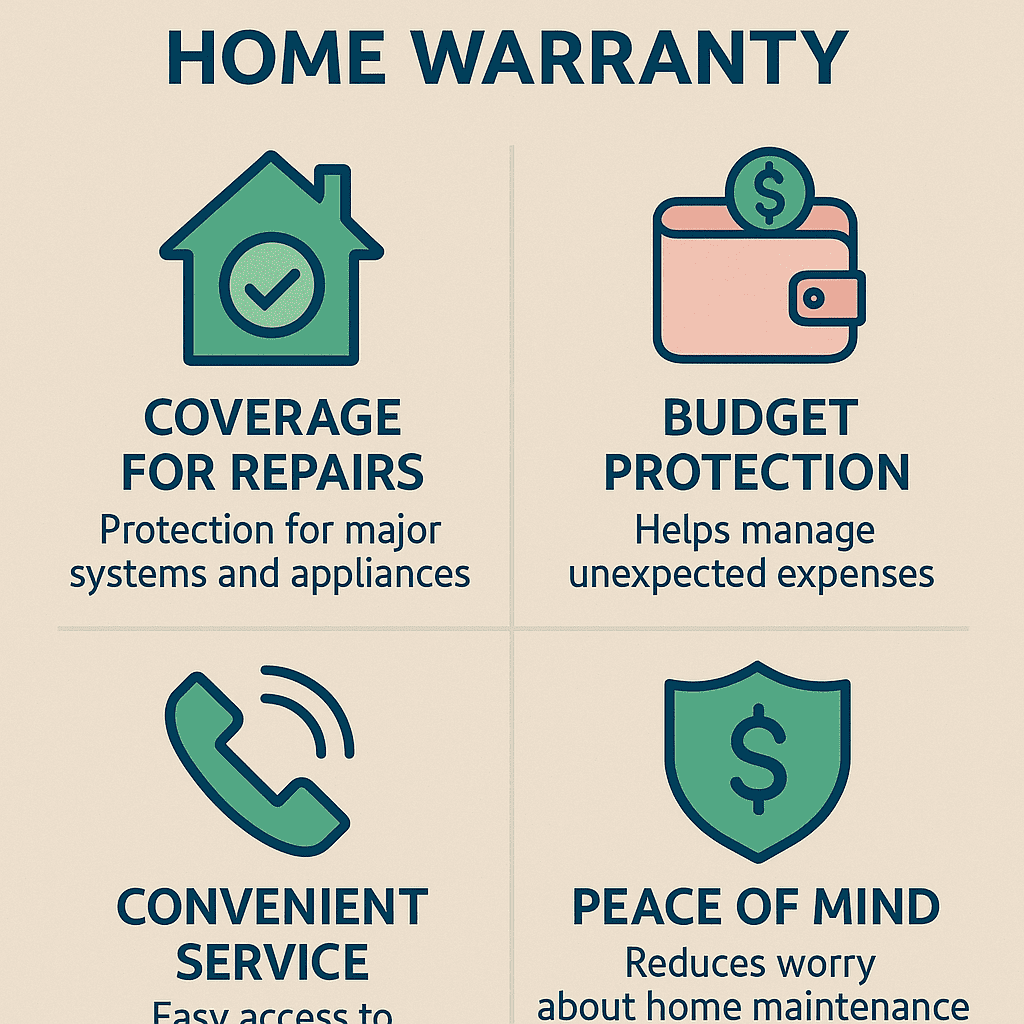Introduction
Picture this: It's the middle of summer, your air conditioning suddenly stops working, and the repair quote is $1,200. Or maybe your refrigerator dies unexpectedly, leaving you with spoiled food and a hefty replacement bill. These scenarios are all too common for homeowners, and they always seem to happen at the worst possible time financially. This is where understanding how a home warranty works becomes invaluable.
Home warranties provide a financial safety net when your home's systems and appliances break down from normal wear and tear. But many homeowners are confused about exactly how these warranties function and whether they're worth the investment. In this comprehensive guide, we'll walk you through the entire process of how home warranties work, from signing up to filing claims, and help you determine if this protection is right for your home.
What Is a Home Warranty?
A home warranty is a service contract that helps cover the cost of repairing or replacing major home systems and appliances when they break down due to normal wear and tear. Unlike homeowners insurance, which protects against damage from specific events like fires or natural disasters, a home warranty focuses on the mechanical failures that occur from everyday use.
Here's how it works in simple terms: You pay an annual premium (typically $300-$600) and a small service fee (usually $75-$125) each time you need a repair. When a covered item breaks down, you contact your home warranty company, they send a qualified technician to diagnose the problem, and if the issue is covered under your contract, they pay for the repair or replacement (minus your service fee).
Home warranties typically cover major systems like HVAC, plumbing, and electrical, as well as appliances such as refrigerators, ovens, washers, and dryers. Some plans also offer optional coverage for items like pools, septic systems, and well pumps.
Benefits of Understanding How Home Warranties Work
Having a clear understanding of the home warranty process offers numerous advantages for homeowners:
Financial Protection
The primary benefit is protection against expensive repair bills. A single major repair can easily exceed the annual cost of a home warranty plan, making it a financially savvy choice for many homeowners.
Streamlined Repair Process
When something breaks, you don't need to spend time researching and vetting contractors. Home warranty companies have networks of pre-screened, licensed technicians, saving you time and ensuring quality repairs.
Budget Predictability
With a home warranty, you pay a predictable annual premium plus a small service fee for each repair. This makes budgeting for home maintenance much easier than dealing with large, unexpected expenses.
Peace of Mind
Knowing that you're protected against common home system failures provides significant peace of mind. You can rest easier knowing that if something breaks, help is just a phone call away.
How Home Warranties Work: Step-by-Step Process
Let's break down exactly how home warranties function from start to finish:
Step 1: Choose and Purchase a Plan
The first step is selecting a home warranty provider and plan that fits your needs. Most companies offer several tiers of coverage, from basic appliance plans to comprehensive coverage that includes both systems and appliances. You'll pay an annual premium upfront or in monthly installments.
Step 2: Waiting Period
Most home warranties have a waiting period (typically 30 days) before coverage begins. This prevents homeowners from purchasing coverage only when they know something is about to break.
Step 3: File a Claim When Something Breaks
When a covered item malfunctions, you contact your home warranty company to file a claim. Most providers offer multiple ways to do this: online, through a mobile app, or by phone. You'll need to provide details about the problem and when it started.
Step 4: Pay the Service Fee
When you file a claim, you'll pay a predetermined service fee (also called a trade call fee). This fee is typically between $75-$125 and is paid each time a technician comes to your home, regardless of whether the item is repaired or replaced.
Step 5: Technician Visit
The home warranty company will dispatch a qualified technician from their network to diagnose the problem. The technician will determine if the issue is covered under your warranty and if it's due to normal wear and tear.
Step 6: Repair or Replacement
If the issue is covered, the technician will either repair the item or, if it's beyond repair, recommend replacement. The home warranty company will cover the cost of parts and labor (up to your coverage limits), minus your service fee.
Step 7: Resolution
Most claims are resolved within a few days, though more complex issues may take longer. If you're not satisfied with the resolution, most companies have an appeals process you can follow.
Top Home Warranty Plans Comparison
To help you choose the right home warranty, we've compared the top plans available. Each offers different levels of coverage and benefits to suit various needs and budgets.
| Plan | Coverage | Limits | Service Fee | Ideal For | Rating | Action |
|---|---|---|---|---|---|---|
| 🏠 Complete Home | Major systems + appliances | $2,000-$5,000 per item | $100 | Comprehensive protection | ★★★★★ | Get Covered |
| 🔧 Systems Plan | Plumbing, electrical, HVAC | $3,000-$7,000 per item | $85 | Older homes with newer appliances | ★★★★☆ | Get Covered |
| 🍳 Appliances Plan | Kitchen + laundry appliances | $1,500-$3,000 per item | $75 | Homeowners with newer systems | ★★★★☆ | Get Covered |
| ⭐ Premium Plan | Complete + optional add-ons | $5,000-$10,000 per item | $125 | Luxury homes and high-end appliances | ★★★★★ | Get Covered |
Pros of Home Warranties
- Financial protection against expensive repairs
- Access to pre-screened, qualified technicians
- 24/7 customer service for emergency repairs
- Simplified process for filing claims
- Potential increase in home resale value
- Budget predictability with fixed service fees
- Coverage for items that homeowners insurance doesn't protect
Cons of Home Warranties
- May not cover pre-existing conditions
- Some claims may be denied due to improper maintenance
- Annual premiums can add up over time
- Service fees apply for each repair visit
- Coverage limits may not fully replace high-end items
How to Choose the Right Home Warranty
Selecting the best home warranty for your needs requires careful consideration of several factors:
Assess Your Home's Needs
Consider the age and condition of your home's systems and appliances. Older homes may benefit more from comprehensive coverage, while newer homes might only need protection for specific items.
Review Coverage Limits and Exclusions
Pay close attention to coverage caps (the maximum amount the warranty will pay for repairs or replacements) and any exclusions that might apply to your situation.
Compare Service Fees
While a lower service fee might seem attractive, it often comes with higher monthly premiums. Calculate your potential annual costs to find the best value.
Research the Provider's Reputation
Look for reviews from current customers and check ratings with organizations like the Better Business Bureau. A company with a strong track record of customer service is worth considering even if their premiums are slightly higher.
Consider Add-On Coverage
Some providers offer optional coverage for items like pools, septic systems, or well pumps that aren't included in standard plans. If you have these features in your home, look for a provider that offers this additional protection.
FAQs About How Home Warranties Work
How quickly can I get service when I file a claim?
Most home warranty companies aim to have a technician at your home within 24-48 hours for non-emergency issues. For emergency situations like no heat in winter or no air conditioning in extreme heat, many providers offer expedited service, often within 24 hours.
Can I choose my own repair technician?
Typically, no. Home warranty companies work with networks of pre-screened, licensed technicians. This allows them to control costs and ensure quality service. However, some providers may allow you to use your own technician if they're licensed and insured, though you'll likely need to pay upfront and seek reimbursement.
What happens if a repair exceeds the coverage limit?
If a repair or replacement costs more than your coverage limit, you'll be responsible for paying the difference. For example, if your coverage limit is $2,000 and the repair costs $2,500, you would pay $500 plus your service fee.
Are there items that typically aren't covered by home warranties?
Yes, common exclusions include non-mechanical items like windows, doors, and structural components; items with pre-existing conditions; and damage due to improper maintenance, code violations, or acts of nature. Cosmetic issues and optional features on appliances are also typically not covered.
Can I transfer my home warranty if I sell my home?
Yes, most home warranties are transferable when you sell your home. This can be an attractive selling point for potential buyers, as it provides them with immediate protection for the home's systems and appliances. There may be a small transfer fee involved.
Final Recommendation
Understanding how home warranties work is essential for making an informed decision about protecting your home and budget. A home warranty can be an excellent investment for homeowners looking to protect themselves from unexpected repair costs and the hassle of finding reliable contractors.
When selecting a home warranty provider, consider your specific needs, budget, and the age and condition of your home's systems and appliances. Look for a reputable company with transparent terms, reasonable coverage limits, and positive customer reviews.
Ready to protect your home and your budget? Take the first step toward peace of mind by exploring your options today.







